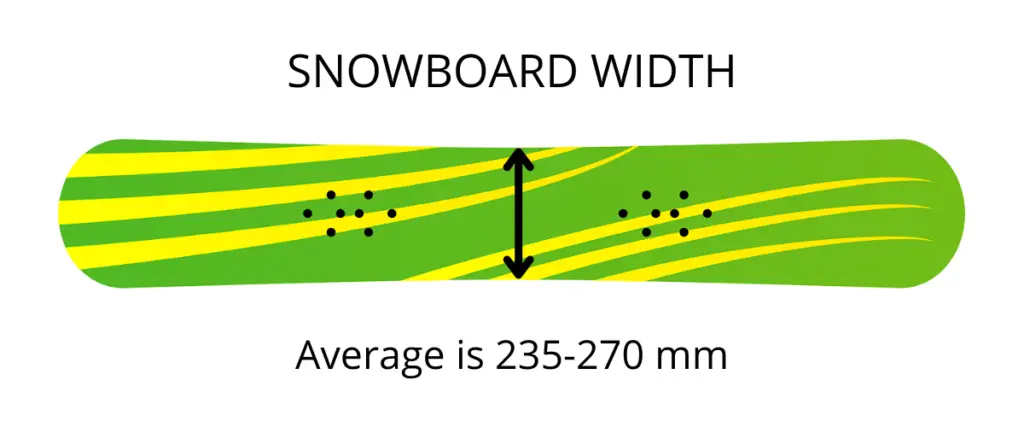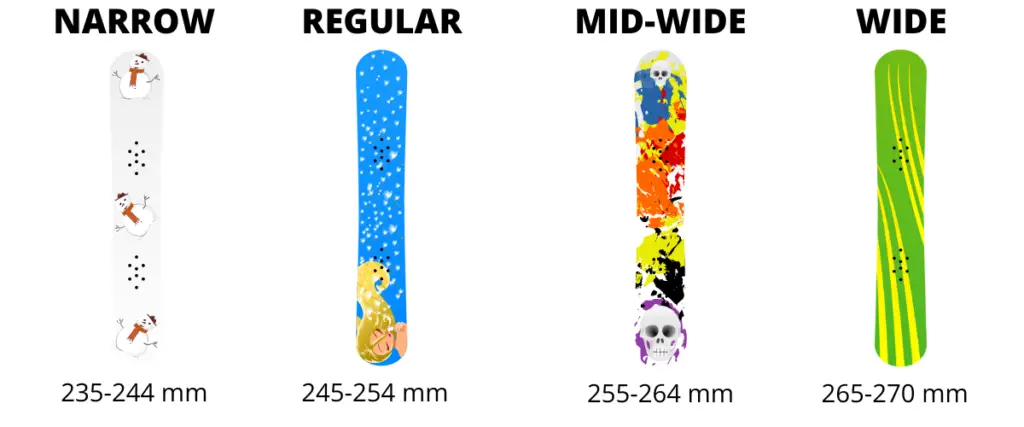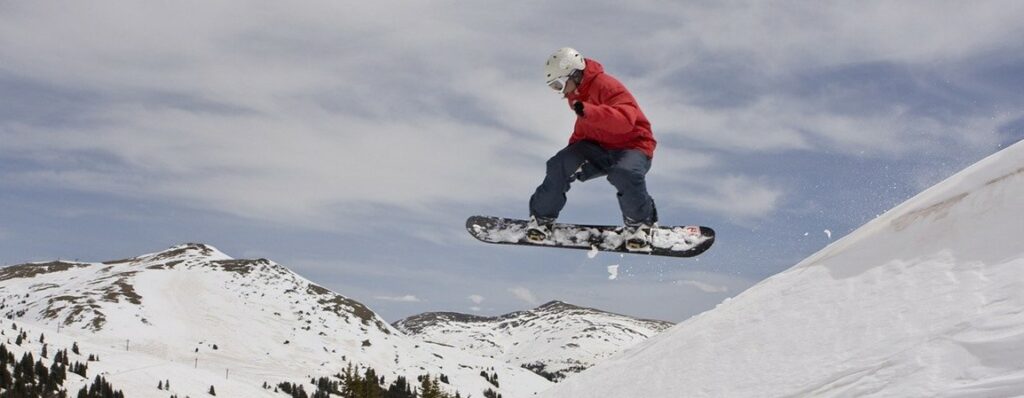Choosing the right snowboard width for your foot size and snowboarding style is essential. In this article, I’ll explain the different snowboard width classifications, the pros and cons of narrow and wide snowboards and how the width affects both comfort and performance.
How Wide are Snowboards?
The width of a snowboard commonly refers to the waist width at the narrowest point. Snowboards have a width of between 235 mm and 270 mm (9.25″ and 10.63″) with the average snowboard being approximately 255 mm wide (10″).

Foot Size and Ideal Snowboard Width
To calculate the ideal snowboard width you should consider the size of your feet primarily.
Snowboards can be categorised into four width classifications:
- Narrow = 235-244 mm/ 9.25-9.60″ waist width
- Regular = 245-254 mm/ 9.65-10.00″ waist width
- Mid-wide = 255-264 mm/ 10.04-10.39″ waist width
- Wide = 265-270 mm/ 10.43-10.63″ waist width

Ideally, your boots should have a slight overhang but not too much (around 0.5″/ 1.3 cm is ideal in most cases). It is recommended to choose a compatible board width for your shoe size to ensure you do not have excessive overhang resulting in toe or heel drag.
If your toes or heels overhang too much then your boots will dig into the snow when you tilt the board at an angle. This happens when carving or when on a steep slope. If your boots come into contact with the snow then you will slide out which is potentially dangerous and will lead to falls.

Here is the ideal snowboard width according to shoe size.
Men’s Shoe Size and Snowboard Width
| Snowboard Width | US | UK | EU | AUS | JAP |
| Narrow (235-244 mm) | 7 or smaller | 6 or smaller | 39 or smaller | 6.5 or smaller | 25 or smaller |
| Regular (245-254 mm) | 8-10 | 7-9 | 41-43 | 7.5-9.5 | 26-28 |
| Mid-wide (255-264 mm) | 11-12 | 10-11 | 44-46 | 10.5-11.5 | 29-30 |
| Wide (265-270 mm) | 13+ | 12+ | 47+ | 12.5+ | 31+ |
Women’s Shoe Size and Snowboard Width
| Snowboard Width | US | UK | EU | AUS | JAP |
| Narrow (235-244 mm) | 8.5 or less | 6.5 or less | 39 or less | 7 or less | 24.5 or less |
| Regular (245-254 mm) | 9-11.5 | 7-9.5 | 40-42 | 7.5-9 | 25-28 |
| Mid-wide (255-264 mm) | 12+ | 10+ | 43+ | 9.5+ | 28+ |
Wide vs Narrow Snowboards
So now we know why you should choose a board according to your shoe size first and foremost, let’s discuss the connotations of choosing a board which is either slightly narrower or wider (but still within a safe range according to your foot size).
The advantages of a wider snowboard are:
- There is less chance of toe/ heel drag when carving hard or on a steeper slope so the risk of sliding out and falling are reduced.
- Wider snowboards feel more stable making them good for high speeds and landing jumps.
- Wider snowboards float more in powder.
The advantages of a narrower snowboard are:
- Narrower snowboards require less effort to turn as they are lighter and there is less distance to rock from the heel to the toe and vice-versa.
- Narrower snowboards can feel faster and less sluggish compared to wider snowboards.
As you can see from the points discussed above, it’s really a balance between stability and agility.
Wider boards are more stable but can feel more sluggish, whereas narrower boards can be harder to control at high speeds and when landing jumps but feel more quick and nimble.
It is not recommended for beginners to use very wide snowboards because they are likely to find them harder to turn on. However, snowboarders with more experience and better technique are unlikely to find a wider board harder to turn on and will benefit more from the extra stability.

Options for Larger Feet
As you’ll notice from the charts above, you may struggle to find a snowboard wide enough if you have particularly large feet as most 270 mm boards are ideal for a size 13 US or size 12 UK men’s shoe size. But don’t worry as there are a few options to make sure you get the ideal snowboard width.
- Some manufacturers make extra-wide snowboards for larger feet. For example, check out the LTB Dream has a width of 320 mm.
- Use a volume-shifted snowboard. These are shorter but wider so they are the same volume as standard boards. For example, the Libtech Orca is a good option.
- Choose a snowboard boot with a “reduced footprint”. This means it has a low profile design so there is less material on the heel and toe so it fits onto the board better and there is less chance of drag when carving.
- You can stand with your feet wider apart as the board tends to be wider the closer you get to the ends. You can also angle your feet a little bit more so they fit on the board better. However, be careful not to adjust your stance too much.
Frequently Asked Questions
Are wider snowboards slower?
Wider snowboards feel slightly slower as they are heavier and it takes more effort to carve so they can feel more sluggish compared to narrower snowboards particularly for beginners who have not developed their technique yet.
Are wider snowboards harder to turn?
Wider snowboards are slightly harder to turn compared to narrower snowboards particularly for beginners as there is more distance to rock from the heel to toe and vice-versa.
Are wider snowboards more stable?
Wider snowboards feel more stable compared to narrower snowboards. This makes wider snowboards the better option for landing jumps.
How do I know if my snowboard is too wide?
If your shoes have no overhang and your boots fit within the snowboard then the board is likely to be too wide for your feet, particularly if you are a beginner.
How do I know if my snowboard is too narrow?
If your boots come into contact with the snow when you are carving. Approximately 0.5″ (1.3 cm) of toe/ heel overhang when the board is flat is ideal.
